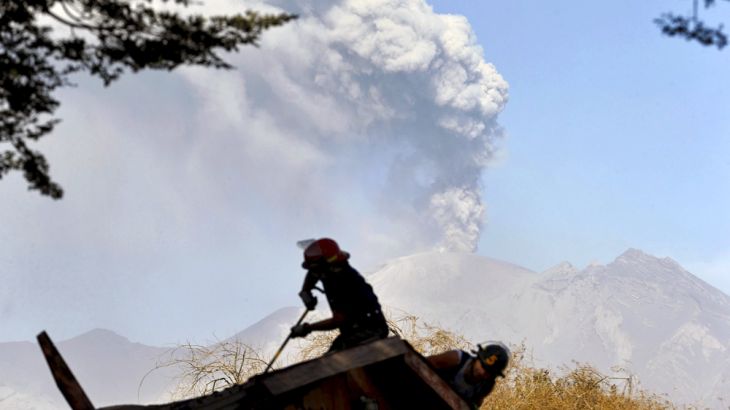Chileans evacuated after volcanic mudflows
Thousands urged to move after mudflows of volcanic debris detected in river close to Calbuco which erupted on Wednesday.

Chilean authorities have urged 2,000 people living near the Calbuco volcano to evacuate after potentially devastating mudflows of volcanic debris were detected in a nearby river, the result of two huge eruptions this week that sent ash across large parts of southern South America.
Officials said on Friday that the evacuations were precautionary but necessary because flows of volcanic mud, known as lahars, are capable of levelling anything in their path once in motion.
Keep reading
list of 4 itemsAfter the Hurricane
World’s coral reefs face global bleaching crisis
Why is Germany maintaining economic ties with China?
The area had been evacuated after the volcano first erupted Wednesday afternoon, but by Friday many people had begun to return home even as Calbuco continued to billow lesser ejections of smoke and ash.
Authorities said the evacuees from the towns of Chamiza, Lago Chapo and Correntoso would stay at shelters in the nearby city of Puerto Montt.
The volcano, which had been dormant four decades, sent a plume of ash about 18km high during Wednesday’s blast.
| Notes from the field: Al Jazeera’s Lucia Newman |
|
Like a sleeping giant rudely awoken, the Calbuco has reminded Chile that 43 years of dormant existence is just a cat-nap in the life of an active volcano. The more than 10-million-year-old volcano erupted suddenly late on Wednesday. Now many of the 4,000 residents of Ensenada, who were forced to evacuate, were briefly allowed to return to the so-called red zone to check on their homes and clear roads and roofs as best they could. A state of emergency remains in effect in towns and cities near the Calbuco. As the volcano continues to belch huge clouds of volcanic ash in the direction of neighbouring Argentina, where air traffic has been severely disrupted, volunteers are distributing food and water to those trying to salvage their belongings, or simply find their pets. |
A second outburst came early on Thursday, with lightning crackling through a dark sky turned reddish orange by the explosion.
The head of the National Mining and Geology Service said on Friday that the volcano’s eruptive process could last weeks and even months and warned that a third eruption was possible.
“What I can say for certain is that this process is not going to end now,” Rodrigo Alvarez said.
“It’s highly likely that we will have other eruptions, maybe not with the same amount of energy, but with activity that can be worrisome.”
The two mighty blasts left Ensenada a ghost town, abandoned by most of its 1,500 residents.
Sitting at the foot of the volcano, the town was covered in thick soot and some roofs collapsed under the weight of the ash.
Just about 16km from Calbuco’s peak, Ensenada is within the official evacuation zone, and most residents complied. But about 30 refused to leave because of worries about their homes and animals.
Ensenada was eerily empty except for a few residents using masks against the ash and an occasional horse or dog roaming its only street.
The 2,000-metre Calbuco, which last erupted in 1972, lies near the cities of Puerto Varas and Puerto Montt, about 1,000km south of Santiago.
Officials worried the clouds of ash could contaminate water, cause respiratory illnesses and ground more airline flights.
But with the coarse dust spreading over nearby countries, Argentine officials grounded flights in Buenos Aires, some 1,485km from the volcano, after a small amount of ash arrived Friday and clouded the sky.
Ash also forced the cancellation of some flights to Uruguay’s capital, Montevideo.
Heavier amounts of ash covered towns closer to the volcano. Cars and streets were coated with a thick blanket of ash in Villa La Angostura, Argentina, a town about 90km northeast of Calbuco.
Weather experts said the haze from the ash would likely clear up quickly unless there was another eruption.
“It doesn’t look like the wind will support a very long trail based on the current forecast,” said Michael Ventrice, an operations scientist at Weather Service International.
![Calbuco, which last erupted in 1972, lies near Puerto Varas and Puerto Montt, about 1,000km south of Santiago [Al Jazeera]](/wp-content/uploads/2015/04/90752aef169b44d787b79126a753ff0f_18.jpeg)